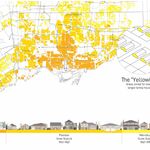denfromoakvillemilton
Senior Member
Member Bio
- Joined
- Apr 30, 2008
- Messages
- 7,410
- Reaction score
- 1,437
- Location
- Downtown Toronto, Ontario
This is politicking. These now way this will have enough riders, even with the new developments.Cost per a new rider is not a very useful measure, as it ignores the benefits for the existing riders.
Counting all riders:
- The cost is $3.4 billion
- 7,300 riders per hour per peak direction
- 7,300 times 3 = 22,000 per 3 morning peak hours
- 22,000 times 2 = 44,000 daily riders per direction
- We will not multiply 44,000 by 2 (opposite direction in the evening), as those are mostly same commuters
Cost per daily rider (existing or new): 3.4B / 44,000 = $77,300. Not bad, given that the infractrusture will work for many decades.
Comparing that to Sheppard East LRT (liked by most of the SSE opponents):
- The cost is $1.2 billion
- 3,000 riders per hour per peak direction
- 3,000 times 3 = 9,000 per 3 morning peak hours
- 9,000 times 2 = 18,000 daily riders, arriving at Don Mills
- We have to take into account that SELRT is a long route; some riders will disembark before reaching Don Mills. I think that 1.5 is a reasonable multiplier to account for those riders.
- Thus, 18,000 times 1.5 = 27,000 daily riders per direction
Cost per daily rider (existing or new): 1.2B / 27,000 = $44,400. Less than for SSE, but not that much different. Plus, the time saved by the average rider due to SELRT will be smaller than the time saved due to SSE.






